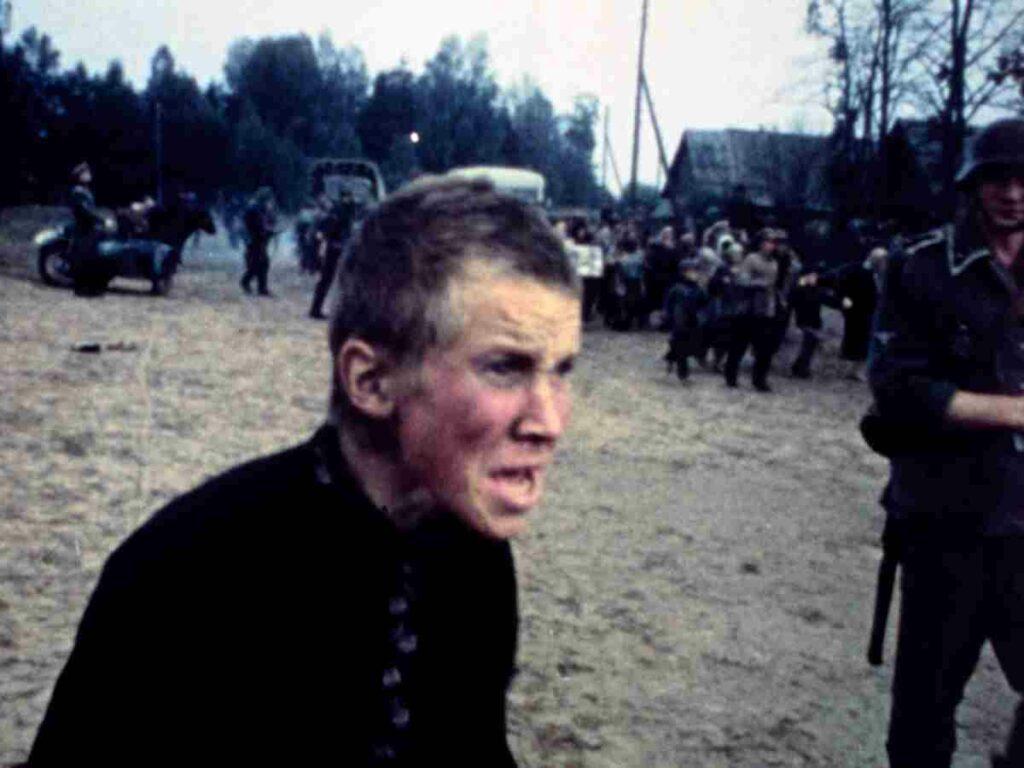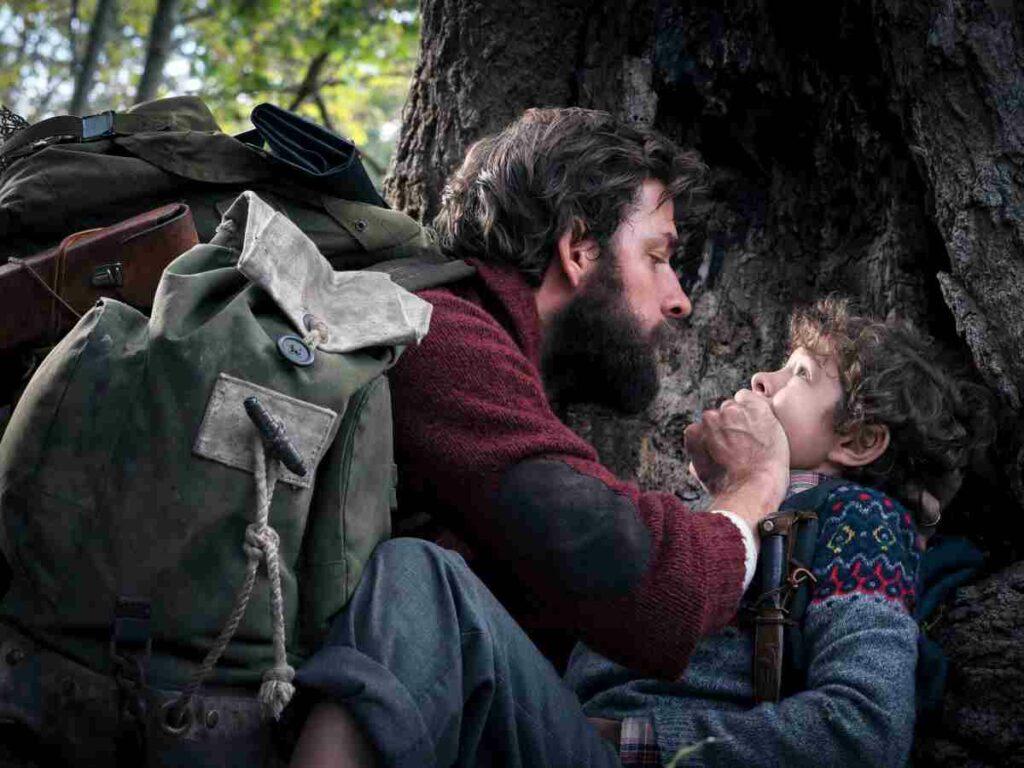From Dunkirk (2017) to Schindler’s List (1993), here are the greatest war movies of all time.
War, like Westerns, is one of cinema’s oldest genres. As filmmaking evolved into a powerful artistic medium in the early 20th century, the world saw the devastation of two World Wars, claiming over 90 million lives. Naturally, stories of combat, sacrifice, valor, and survival became a focal point for European and American filmmakers. Among them was D.W. Griffith’s The Birth of a Nation (1915), a landmark silent epic—but also a deeply flawed and racist retelling of the American Civil War.
Long before Chaplin made The Great Dictator, he directed Shoulder Arms (1918), a 45-minute war comedy set during World War I. Then came one of silent cinema’s most devastating war films, Raoul Walsh’s The Big Parade (1925). In 1927, Abel Gance’s five-and-a-half-hour epic Napoleon redefined battle sequences, showcasing war scenes that remain breathtaking today. That same year, the first Academy Awards were held, with Wings, a World War I drama, winning Best Picture.
The birth of talkies in 1927 only amplified the emotional depth of war films. Two anti-war classics emerged in 1930: Lewis Milestone’s All Quiet on the Western Front and G.W. Pabst’s Westfront 1918, both portraying the horrors of war through the perspective of German soldiers.
Yet, as tyranny spread across 1930s Europe, the world plunged into its deadliest conflict. History repeated itself, despite visionary filmmakers exposing the bleak reality of war. Understanding these conflicts through cinema offers a vital humanistic perspective.
With that, let’s dive into the greatest war films of all time:
Best War Movies of All Time
20. Glory (1989)
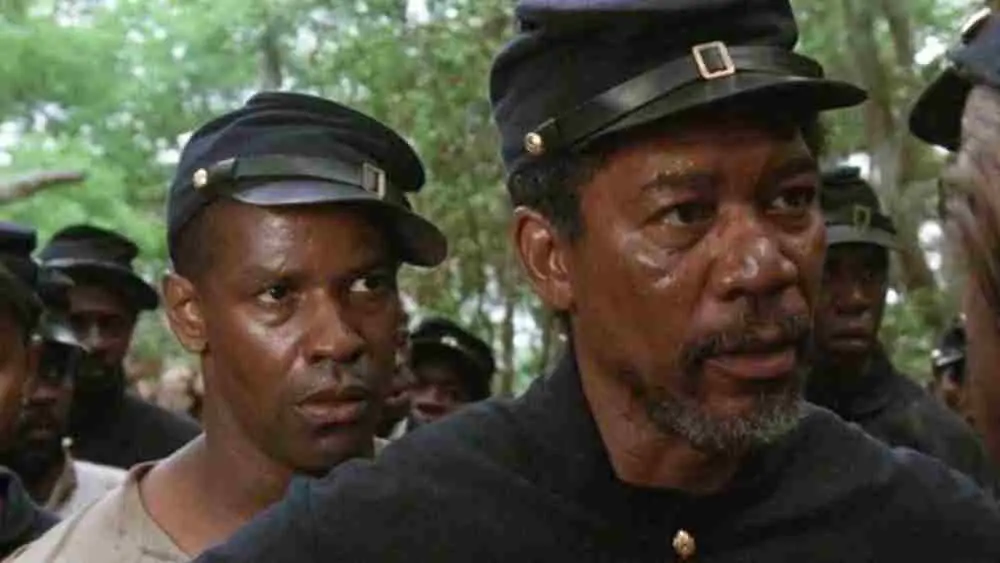
Edward Zwick’s Glory sheds light on a vital yet often overlooked chapter of the American Civil War (1861–1865). Based on Peter Burchard’s One Gallant Rush, the film follows the 54th Massachusetts Volunteer Infantry, the first all-Black regiment in the Civil War. Glory captures the diverse experiences of Black soldiers in the 19th century. Matthew Broderick plays Robert Gould Shaw, the Colonel of the Union Army’s all-black regiment. The white officer Shaw not only leads his men on the battlefield, but understands their fight against racial injustice.
The film boasts a stellar ensemble cast, including Morgan Freeman, Cary Elwes, and Bob Gunton. However, it’s Denzel Washington’s performance as Trip—a defiant former slave—that makes Glory unforgettable. His harrowing whipping scene, particularly as the camera slowly zooms into his face, is stirring. The role earned Washington an Oscar for Best Supporting Actor. While Glory takes dramatic liberties with certain events and characters, it remains a stirring portrayal of the Civil War’s brutality and the resilience of those who fought for freedom. The poignant final scene lingers long after.
Where to watch: Google Play Movies, Apple TV+
WATCH: 11 Stunning Examples of Visual Storytelling
19. Dunkirk (2017)

The evacuation of over 338,000 Allied soldiers (May 26-June 4, 1940) from Dunkirk was a pivotal moment in WWII. While previous films have depicted the rescue, Nolan’s Dunkirk (2017) delivers an immersive, nerve-wracking experience that captures the soldiers’ despair, courage, and sacrifice. With Nazi forces closing in from land, air, and sea, the stakes couldn’t be higher. Nolan’s use of multiple timelines and perspectives—spanning land, air, and water—brilliantly conveyed the chaos and urgency of the battle.
Where to watch: Apple TV+, Jio Cinema
18. Letters from Iwo Jima (2006)

American movies rarely humanize the ‘enemies’ they fought against. Directed by Clint Eastwood, who is generally regarded as the conservative icon in America, Letters from Iwo Jima came as a surprise. Eastwood made two WWII movies in 2006, focusing on the 1945 Battle of Iwo Jima. While Flags of Our Fathers chronicles the American soldiers’ perspective of the war, Letters from Iwo Jima offers a grim portrait of Japanese soldiers’ suffering. The film was made with a perfect Japanese cast, and almost all the dialogues are in Japanese (script written by Iris Yamashita). More importantly, the film authentically depicts the Japanese history and culture.
The story unfolds through two perspectives: General Kuribayashi (Ken Watanabe), a pragmatic leader who understands the war’s hopelessness, and Saigo (Kazunari Ninomiya), a young baker whose life is upended by Japan’s rigid militaristic regime.
While Letters from Iwo Jima takes creative liberties with history, it powerfully humanizes the soldiers who sacrificed their lives for a futile cause. The film resonated deeply in Japan, dominating the box office for five consecutive weeks.
Where to watch: Apple TV+, YouTube
17. The Deer Hunter (1978)
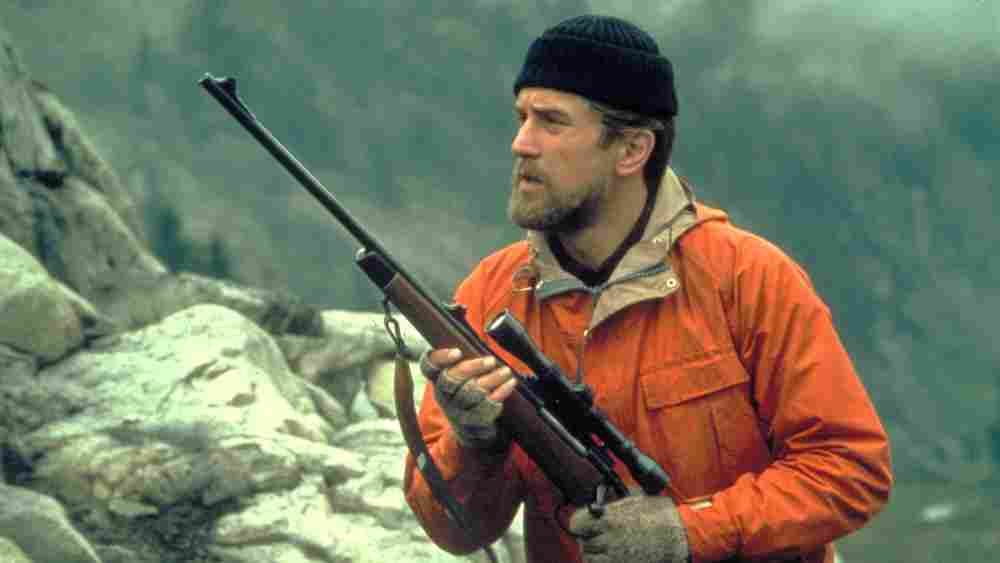
John Wayne’s The Green Berets (1968) was one of the first American war films to depict Vietnam, but it was widely criticized for its clichés and lack of depth. It wasn’t until after the war ended in 1975 that filmmakers began exploring the conflict through a more nuanced sociopolitical lens.
One of the most powerful early Vietnam War films was Michael Cimino’s The Deer Hunter (1978). The three-hour epic follows Michael (Robert De Niro), Nick (Christopher Walken), and Steven (John Savage), childhood friends from a Pennsylvania steelworker community who, like many ordinary Americans, are sent to fight in Vietnam.
Captured by the North Vietnamese army, they endure brutal imprisonment and are forced into a horrific game of Russian Roulette—a haunting symbol of war’s insanity. Though they escape, the psychological scars follow them home, unraveling their lives.
The Deer Hunter is an unflinching portrayal of the mental toll of war, driven by an exceptional cast, including De Niro, Walken, Meryl Streep, and John Cazale.
Where to watch: Netflix
16. The Big Red One (1980)
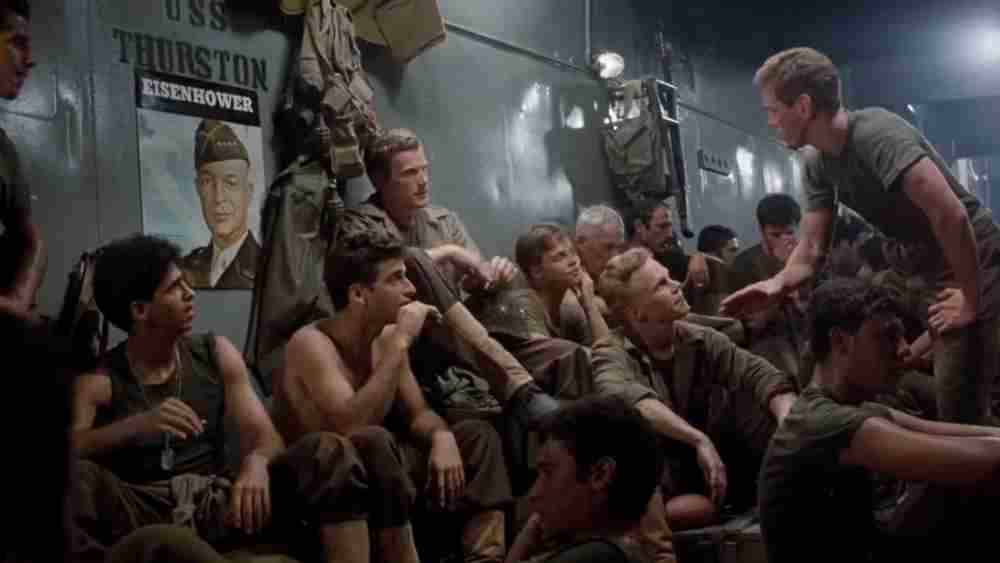
ournalist, novelist, and WWII veteran Samuel Fuller was a radical filmmaker who emerged in the late 1940s, making low-budget genre films that tackled taboo themes Hollywood often ignored. The Steel Helmet (1951) remains one of the boldest depictions of the Korean War, but it’s The Big Red One, based on Fuller’s own semi-autobiographical memoir, that stands among the greatest war films ever made.
Written two decades before its production, The Big Red One follows a hardened, unnamed sergeant (Lee Marvin) leading his infantry squad through North Africa during World War II. Unlike the sweeping war epics of David Lean, Coppola, or Spielberg, Fuller’s film narrows its focus to the brutal, limited perspective of the soldiers on the ground.
Like Joseph Heller’s tragic and hilarious novel Catch 22, the film captures the absurd logic of war. Fuller masterfully blends dark humor with his terrifying visions of combat. Despite its episodic narrative structure, The Big Red One grips us till the end, thanks to the powerhouse performances and sharp editing.
Where to watch: Tubi, Roku
15. Patton (1970)
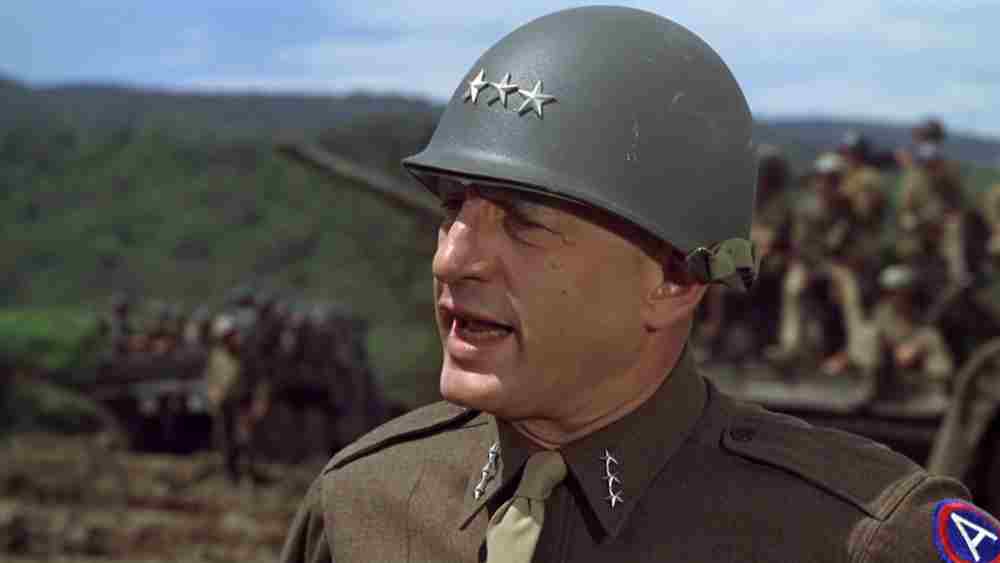
George S. Patton Jr. was a flamboyant and controversial US general who served on the Western Front and North Africa during WWII. Franklin J. Schaffner’s 1970 biopic, Patton, co-written by a young Francis Ford Coppola, captures the complexity of this larger-than-life figure. Though Coppola knew little about Patton or his Third Army, he conceived the film’s now-iconic opening—Patton’s rousing pep talk delivered in front of a massive American flag. George C. Scott, with his commanding presence, embodies Patton’s intensity from this unforgettable six-minute monologue.
Under Patton’s leadership, the Third Army tore through France and Germany, famously rescuing the 101st Airborne at Bastogne during the Battle of the Bulge. Yet the film also highlights Patton’s abrasive personality, particularly in the infamous scene where he berates a shell-shocked soldier as a “coward.”
Schaffner’s movie also has some marvelous battle sequences. Eventually, Patton moves beyond the scope of a biopic and takes a satirical dig at militarism.
Where to watch: YouTube, Apple TV+
14. Fires on the Plain (1959)
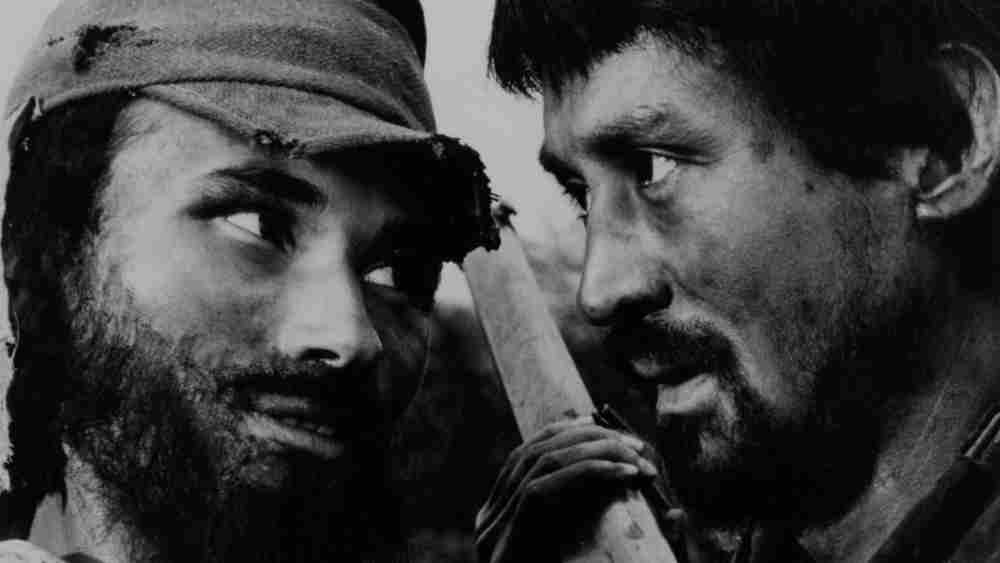
Masaki Kobayashi’s The Human Condition trilogy (1959–1961), based on Junpei Gomikawa’s six-part novel, is a masterful humanist drama depicting wartime Japan. However, it is Kon Ichikawa’s Fires on the Plain (1959) that delivers one of the most harrowing portrayals of Japanese soldiers’ psychological and physical suffering.
Based on Shohei Ooka’s novel, the film follows Tamura (Eiji Funakoshi), a tuberculosis-stricken soldier stationed in the jungles of the Philippines during the final days of World War II. With food supplies dwindling, he is sent to a field hospital for treatment, but his journey turns into a waking nightmare. As he walks through a landscape consumed by war, Tamura witnesses unspeakable horrors and the depths of human depravity.
Though Fires on the Plain is relentlessly bleak, it carries a macabre sense of humor. Ichikawa conjures apocalyptic imagery—fields littered with corpses, desperate soldiers reduced to their primal instincts. The film explores the darkest corners of the human soul, and Funakoshi’s haunting, hollow-eyed performance lingers long after. His searing close-up shots remind us of the traumatized boy in Come and See.
Where to watch: The Criterion Channel, Kanopy
13. The Bridge on the River Kwai (1957)
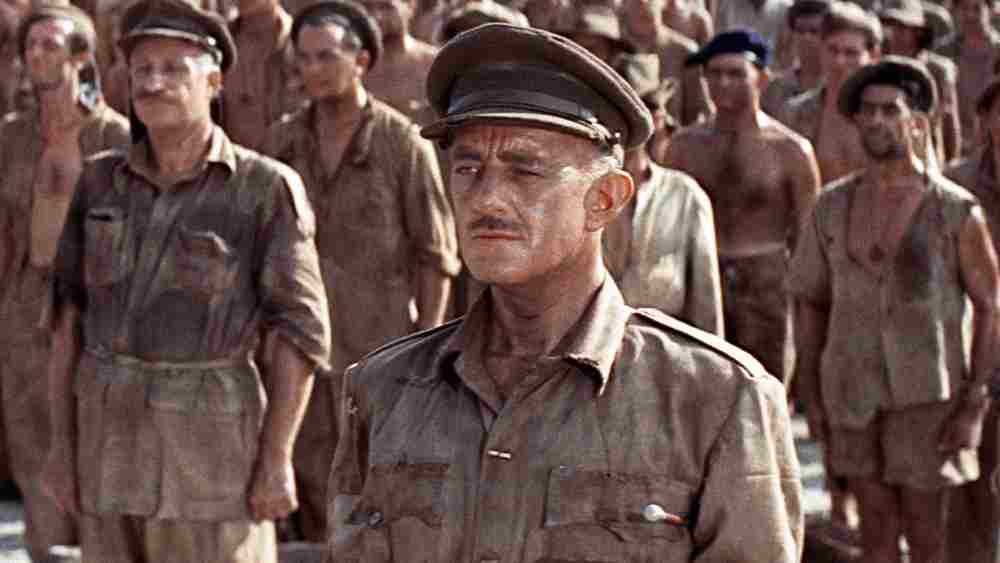
The riveting WWII epic solidified David Lean’s stature as an icon of grand-scale filmmaking. His subsequent masterpieces include Lawrence of Arabia (1962) and Doctor Zhivago (1965). Adapted from Pierre Boulle’s 1952 French novel, the story unravels the lives of British soldiers held captive in a Japanese camp on the border of Burma and Thailand. The steadfast Colonel Nicholson, portrayed by Alec Guinness, upholds order amongst the British POWs. Meanwhile, the camp’s leader, Colonel Saito, emerges as a brutal figure, inflicting both physical and psychological pain on the English soldiers.
When the POWs are tasked with building a bridge over Kwai to invade India, they secretly attempt to botch the work. The film does tend to overtly mythologize the so-called British ingenuity and resolve. Yet it remains a stunning world war drama with extraordinary mise en scene. The film’s wild and mesmerizing climax remains one of the most thrilling sequences in film history. The movie won 7 of the 8 Academy Awards it was nominated for, including Best Picture.
Where to watch: Prime Video, Apple TV+
12. All Quiet on the Western Front (1930)

German novelist and First World War veteran Erich Maria Remarque published his classic anti-war novel, All Quiet on the Western Front, in 1928. American filmmaker Lewis Milestone adapted the novel as Nazism was on the rise in Germany. It was considered to be the first best war film of the sound era and claimed the Oscars for Best Director and Best Picture. The plot revolves around Paul Baumer (Lew Ayres), a naive boy with a romantic delusion about war. We see his disillusionment grow as he endures brutal military training and is later thrust into a chaotic trench warfare.
All Quiet on the Western Front set a precedent for war movies that questioned the shallow ideals related to warfare, like glory, honor, and bravery. Milestone’s visual storytelling is brilliant, especially the haunting scene of a soldier reaching for a butterfly before being shot. The acting reflects the expressive style of the silent film era, which may feel dated to some. Its raw depiction of war angered both the Nazis and the American Legion. In 2022, German-Austrian filmmaker Edward Berger adapted the novel into a Netflix Original.
Where to watch: Tubi
11. Saving Private Ryan (1998)
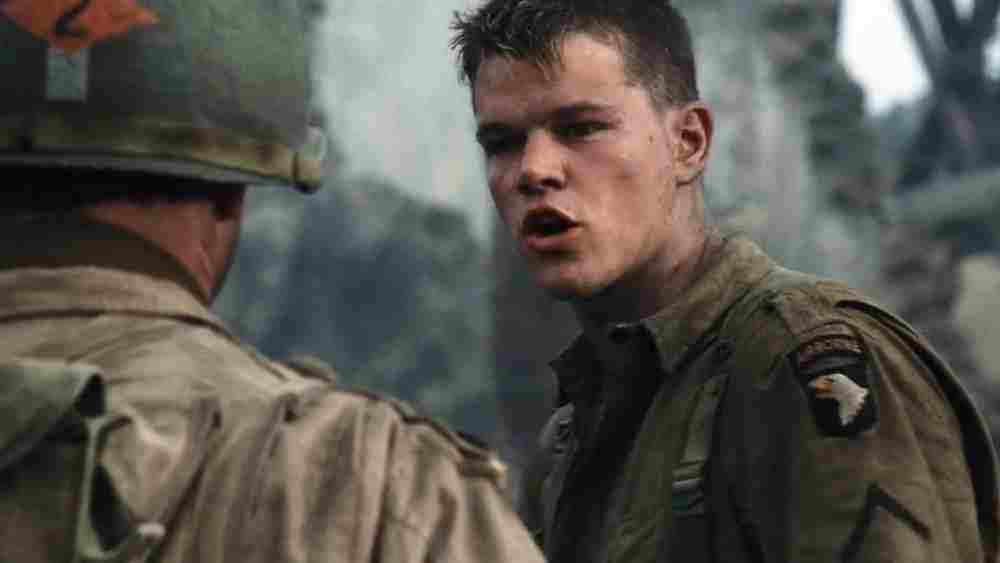
Steven Spielberg’s Saving Private Ryan is hailed for its realistic portrayal of combat action. Its harrowing D-Day landing sequence redefined how military violence is depicted on screen, blending Spielberg’s meticulous staging with a raw, documentary-style approach. The film reshaped the war genre, influencing later movies like Hacksaw Ridge, 1917, and Dunkirk.
The story follows Captain John H. Miller (Tom Hanks) as he leads his men across the blood-soaked beaches of Normandy. Soon, they embark on a dangerous mission behind enemy lines to locate and rescue Private Ryan (Matt Damon).
Beyond its groundbreaking mise-en-scène, Saving Private Ryan boasts a strong script by Robert Rodat, based on the writings of Stephen E. Ambrose. The film highlights the diverse backgrounds of American soldiers and the humanity within war. Each character is well-developed, brought to life by an outstanding cast, including Tom Sizemore, Giovanni Ribisi, Vin Diesel, and Barry Pepper.
Where to Watch: Apple TV+
10. Full Metal Jacket (1987)
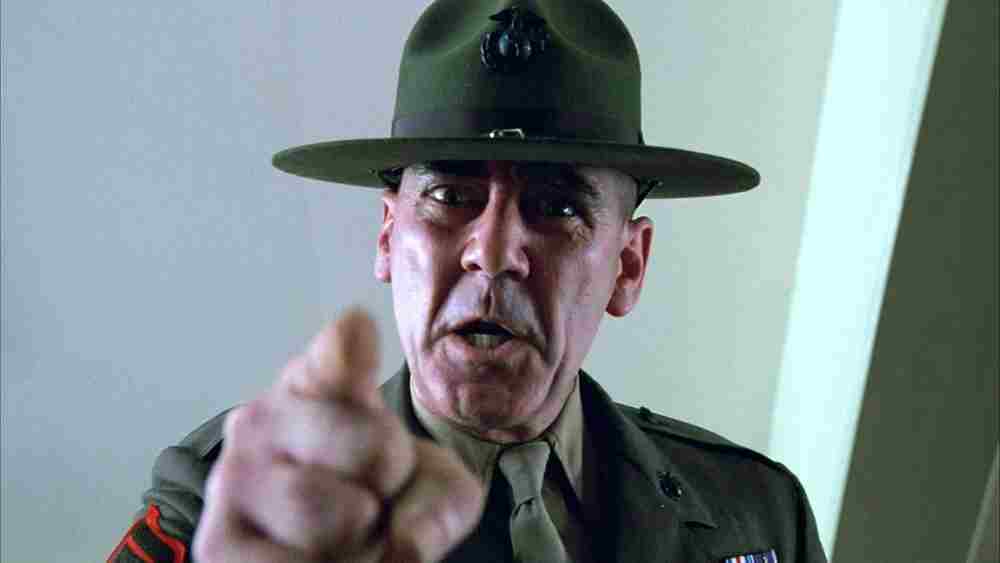
Stanley Kubrick delivered a scathing critique of military bureaucracy in Paths of Glory (1957) and brilliantly satirized the indifference of the powerful in Dr. Strangelove (1964). With Full Metal Jacket, his Vietnam War masterpiece, he shifts focus to the brutal conditioning of young recruits, shaping them into lethal soldiers. This film is darker and more unsettling than his previous political works.
The first half follows the relentless boot camp training of U.S. Marines under the ruthless Gunnery Sergeant Hartman (R. Lee Ermey). Ermey’s performance is both terrifying and darkly comedic. Private Pyle, an overweight and struggling recruit, becomes the target of Hartman’s relentless abuse. The first half culminates with an explosive and shocking moment.
The second half moves to Vietnam, where the soldiers face the chaos of war. While hyper-masculine action movies were on the rise in the 1980s, Kubrick showcases war’s profound impact on an individual’s psyche. Unlike traditional war films, he offers no moment of reflection or hope. We are simply left with an experience deeply scarring.
Where to watch: Tubi, Paramount +
9. The Ascent (1977)
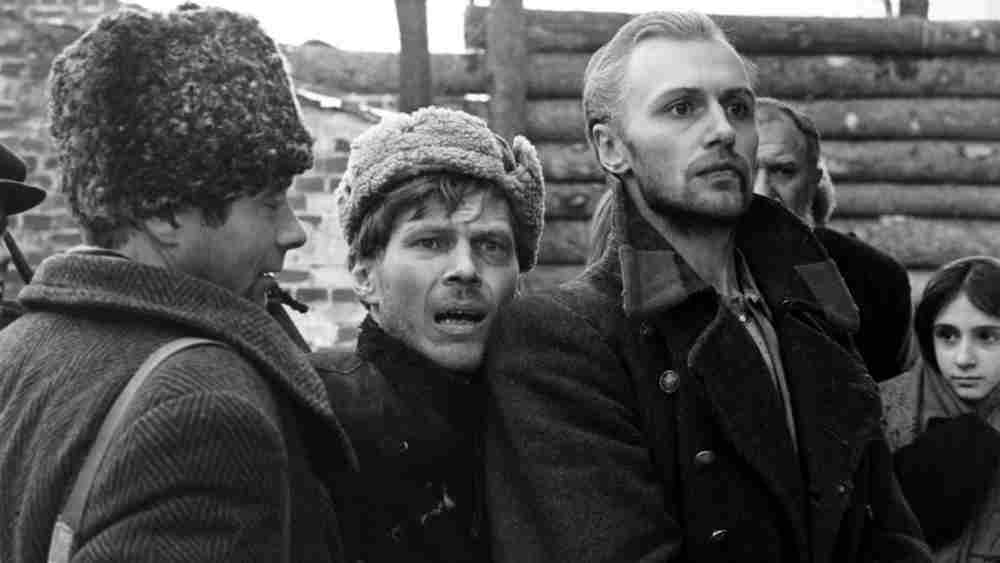
Ukrainian Soviet filmmaker Larisa Sheptiko, a VGIK film school classmate of Andrei Tarkovsky and Sergei Parajanov, got her international breakthrough with this World War II masterpiece. Based on Vasily Bykov’s novella, The Ascent follows two Soviet partisans, Sotnikov (Boris Plotnikov) and Rybak (Vladimir Gostyukhin) as they walk through a bleak, snow-covered landscape in search of food for their troops. Their mission takes a grim turn when they are captured by the Germans and subjected to brutal interrogation by a Belorussian collaborator, Portnov (Anatoly Solonitsyn).
The Ascent is a profound commentary on sacrifice and self-preservation in the backdrop of war. The story is best known for its gracefully realized biblical metaphors as Sotnikov, an asthmatic former school teacher, is elevated to a Christ-like figure. At the same time, Rybak, the strong soldier, gradually becomes a Judas to Sotnikov’s Christ. The war film is a testament to the exceptional talent of Sheptiko, who tragically perished in a car accident in 1979. The heartfelt close-ups remind us of Dreyer’s silent masterpiece, Passion of Joan of Arc (1928). Shot in the brutally cold climes of the Kazakh steppe, The Ascent presents the natural world as a character in itself.
Where to watch: YouTube
8. Apocalypse Now (1979)

Francis Ford Coppola (in)famously proclaimed at the 1979 Cannes, “My film is not about Vietnam, it is Vietnam.” In fact, Apocalypse Now became one of the most emblematic works of the absurdities and brutalities of the Vietnam War. The film’s chaotic production schedule also led to the making of a darkly fascinating behind-the-scenes doc. Loosely based on Joseph Conrad’s 1899 novella Heart of Darkness, Coppola changes the setting from colonized Africa to war-torn Southeast Asia.
We follow US Army officer Captain Willard (Martin Sheen), who is sent on a mission to Cambodia to assassinate the allegedly insane renegade Colonel Kurtz (Marlon Brando). Kurtz is said to have killed countless innocents, set up his own dominion within the jungle, and revered as a demi-god by the indigenous people.
The movie is an unflinching commentary on America’s involvement in the Vietnam War. From Lt. Colonel Kilgore’s (Duvall) obsession with the ‘scent of napalm’ to the breathtaking helicopter assault sequence and the harrowing water buffalo scene, Coppola crafts an emotionally charged experience.
Apocalypse Now has three versions, though the ‘Final Cut’ is considered the definitive one.
Where to watch: Apple TV+
7. The Grand Illusion (1937)
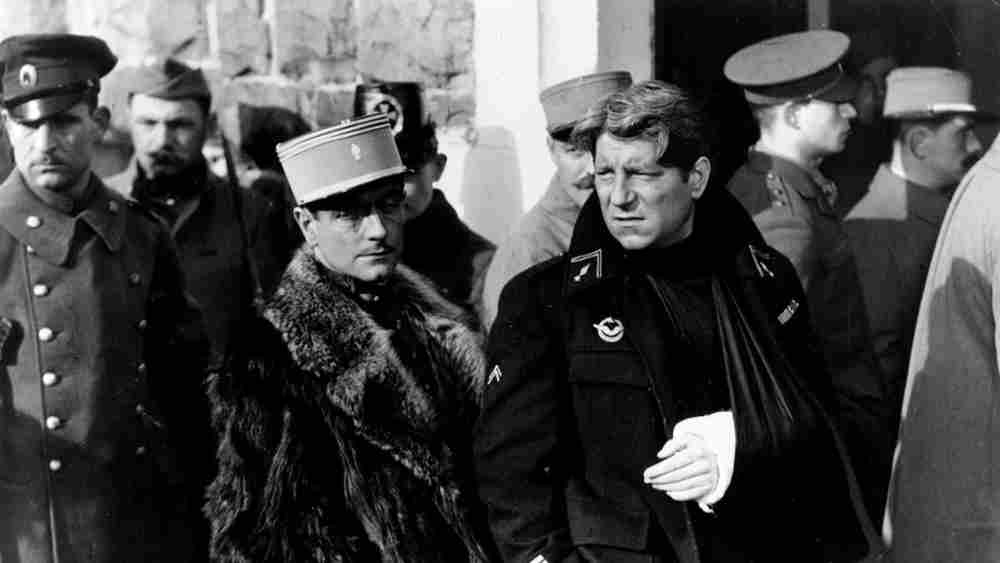
Jean Renoir, a pioneer of poetic realism, crafted one of cinema’s greatest anti-war films with Grand Illusion. Its pacifist message so enraged Nazi propaganda minister Joseph Goebbels that he labeled it “cinematic public enemy No. 1”. In fact, Goebbels ordered it to be destroyed, and the film negative was thought to be lost during an air raid in 1942. Thankfully, the original negative survived the World War II.
Co-written by Renoir and Charles Spaak, the film is set during World War I and follows French Captain de Boeldieu and Lieutenant Maréchal (Jean Gabin), who are captured after their plane is shot down. After multiple escape attempts, they are transferred to a high-security fortress overseen by Captain von Rauffenstein (Eric Von Stroheim).
While Grand Illusion features thrilling moments like other classic POW films such as Stalag 17 (1953) and The Great Escape (1963), its depth lies in its rich characterization and powerful social themes. Renoir, best known for his intricate and vivid camerawork, carefully frames the events. His techniques have influenced a generation of filmmakers. One of the film’s most compelling elements is the nuanced camaraderie between Rauffenstein and de Boeldieu.
Where to watch: Criterion Channel
6. Das Boot (1981)
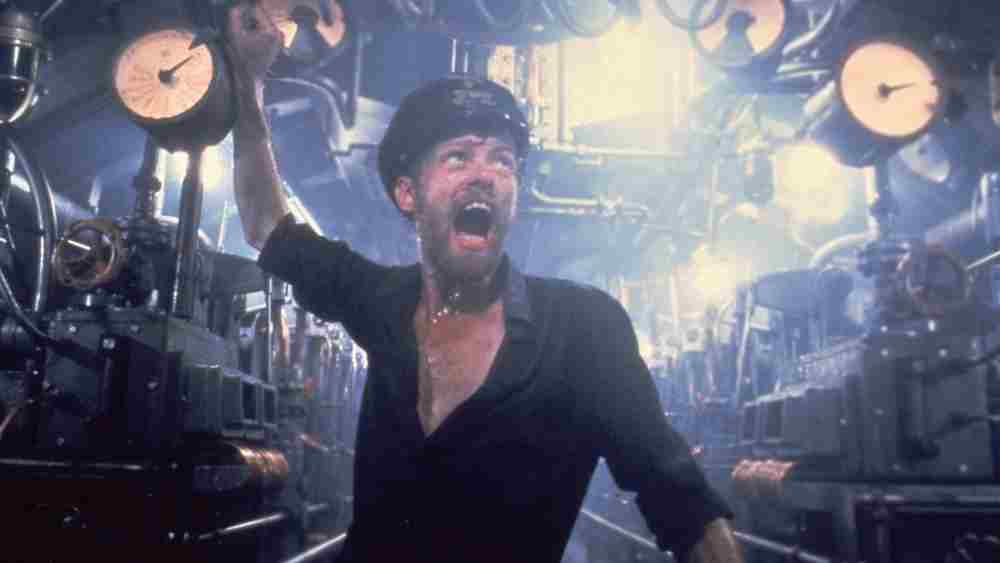
Wolfgang Petersen’s claustrophobic anti-war masterpiece exposes the disturbing realities of submarine warfare during WW2. Based on German novelist Lothar-Gunther Buchheim’s 1973 novel of the same name, Das Boot (The Boat) was in production for nearly two years. Its $15 million budget made it the most expensive German film of the time. The production involved constructing several U-boats, including a detailed full-sized model for interior filming. The story is primarily set inside the U-96 submarine and follows its weary crew as they embark on a dangerous mission across the Atlantic Ocean.
With stunning cinematography by Jost Vacano and outstanding performances from its ensemble cast, Das Boot delivers an unflinching look at war’s psychological toll. Petersen also explores the resilience of the human spirit, depicting ordinary German soldiers caught in the oppressive machinery of the Third Reich.
5. The Thin Red Line (1998)

After two decades away from filmmaking, Terrence Malick returned with The Thin Red Line, a haunting World War II drama. Based on James Jones’ 1962 novel, the film follows Charlie Company as they battle Japanese forces on the island of Guadalcanal.
Released the same year as Saving Private Ryan, The Thin Red Line took a completely different approach. While Spielberg’s film delivered visceral realism, Malick focused on the psychological and philosophical toll of war. He crafted a meditative, poetic exploration of humanity in chaos.
Malick’s films often take time to be fully appreciated, and The Thin Red Line was no exception. Over the years, its impact has only grown. John Toll’s cinematography and Hans Zimmer’s evocative score perfectly aid Malick’s idea. The cast – Sean Penn, Adrien Brody, Nick Nolte, Jim Caviezel, John Cusack, and Woody Harrelson – is equally impressive.
Where to watch: Apple TV+
4. Grave of the Fireflies (1988)
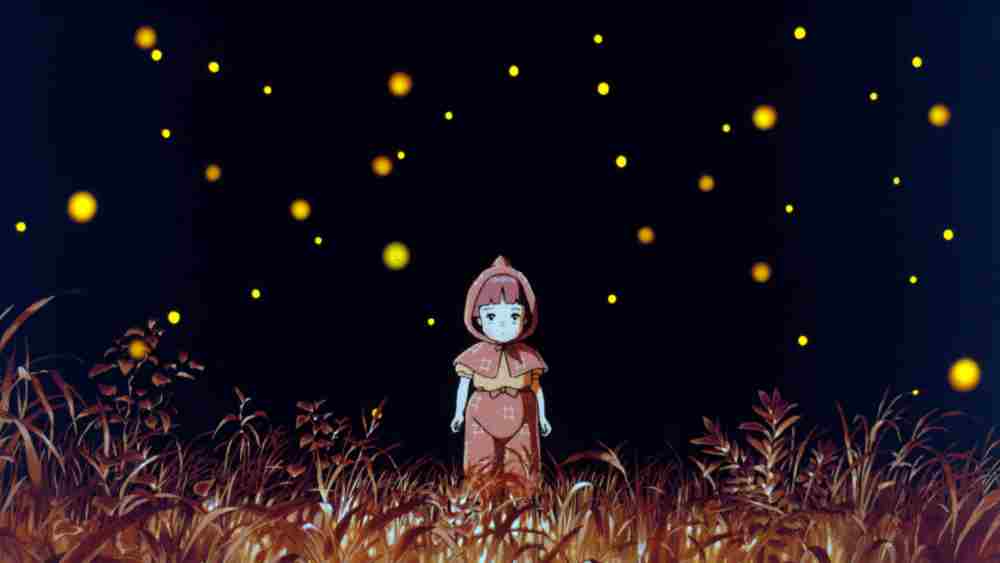
War isn’t always waged in the battlefronts and Isao Takahata’s Grave of the Fireflies is a devastating reminder. Drawing from Akiyuki Nosaka’s eponymous short story, the story follows orphaned siblings, Seita and Setsuko who struggle to survive the desperate final months of World War II.
Having personally survived a U.S. air raid in wartime, Takahata unflinchingly captures the human cost of war. Animation has long been misunderstood as a genre for kids’ entertainment. But Studio Ghibli has, time and again, realized the full potential of the artistic medium through stories of profound gravity. “Why do fireflies have to die so soon?”, little Setsuko questions Seita. The question lingers long after, forcing us to confront the silent tragedy of those who endure war but have no voice in its making.
Where to watch: Netflix
WATCH: 10 Greatest Yasujiro Ozu Movies, Ranked
3. Schindler’s List (1993)

Spielberg’s Schindler’s List is a harrowing depiction of one of World War II’s most remarkable true stories. Based on Thomas Keneally’s Schindler’s Ark (1982), the film follows Oskar Schindler (Liam Neeson), a flawed German businessman who saved over 1100 Jews during the Holocaust.
Schindler was no ideal hero—he was a Nazi spy and an opportunistic industrialist who initially sought to profit from the war. After Germany’s invasion of Poland in 1939, he set up a factory in Krakow, employing displaced Jewish workers. However, as he witnessed the horrors of the SS and Hitler’s brutal policies, he had a change of heart. With the help of his Jewish accountant, Itzhak Stern (Ben Kingsley), Schindler devised a plan to save as many lives as possible.
Spielberg takes some creative liberties to heighten the emotional impact, but the film’s power lies in its raw, immersive storytelling. The haunting mise-en-scène and expressive staging make the Holocaust’s devastation painfully real. Schindler’s List won 7 Oscars, including Best Picture.
Where to watch: Prime Video, Netflix
2. Paths of Glory (1957)
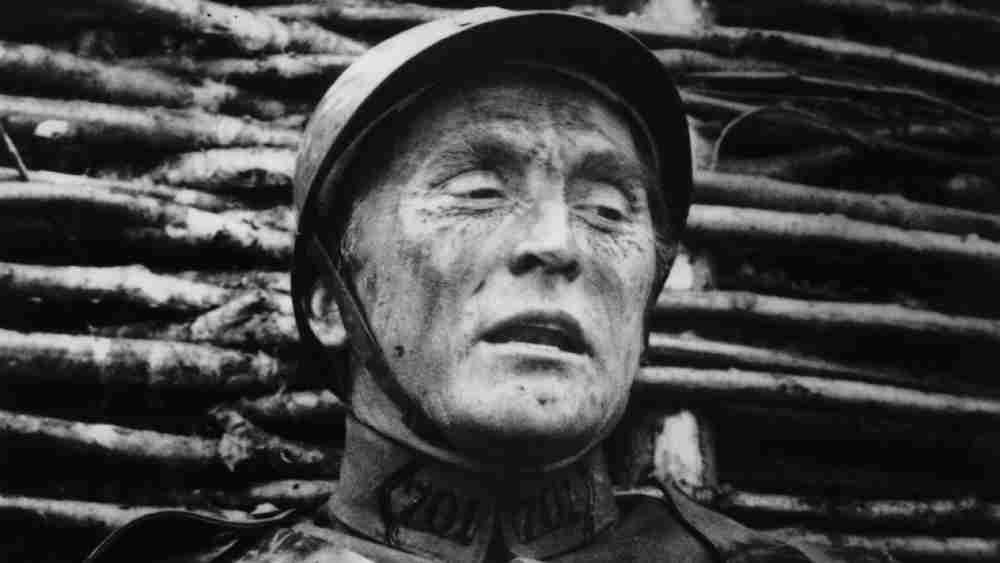
While many war films delve into the psychological and physical horrors of war, Stanley Kubrick’s Paths of Glory shifts the lens towards the inherent moral decay and class-based discrimination within the military establishment. Starring Kirk Douglas, Paths of Glory is based on Humphrey Cobb’s eponymous 1935 novel, and is inspired by actual events in the French military during World War I. We follow Colonel Dax (Kirk), a French Army officer who is ordered to command his unit in an assault on a heavily fortified German outpost known as ‘Anthill.’ When the mission inevitably fails, the tyrannical General Mireau tries to scapegoat the soldiers by putting them on trial for cowardice.
Dax, who is also a criminal defense lawyer, defends the men at the military trial and tries to save them from execution. Kubrick’s film indicts the outdated, inhumane ideologies of the conceited army chiefs, who atrociously violate human rights without facing the consequences. It shows how countless lives are sacrificed for the arrogance and ego of a few. Released during a period when the U.S. was increasingly involving itself in global warfare, Paths of Glory came in timely as an anti-war commentary.
Where to watch: Apple TV+
1. Come and See (1985)
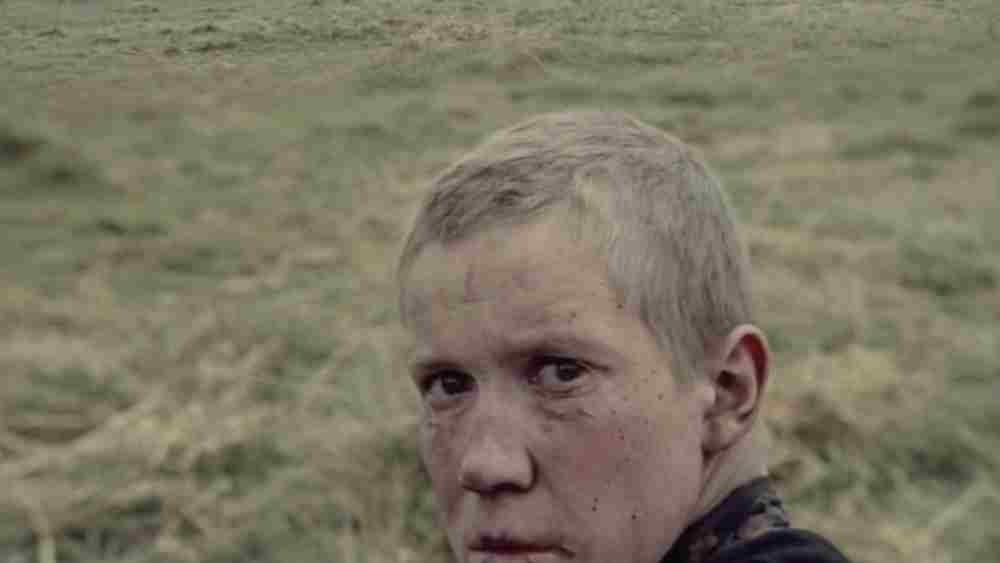
Elem Klimov’s Come and See follows the harrowing odyssey of Flyora (Aleksey Kravchenko), a teenager eager to join the Belarusian resistance against the Nazis. Set in Nazi-occupied Belarus in 1943, his dreams of becoming a soldier quickly unravel into a nightmarish odyssey that exposes the true horrors of war.
While many war films turn real-life tragedies into gripping action sequences, Come and See does the opposite. Klimov immerses viewers in a disturbingly visceral experience, making the horrors of war feel inescapable. The film’s production was fraught with challenges, from Soviet censorship to a grueling filming process. Though praised at festivals, it took decades for Come and See to be recognized as one of the greatest anti-war films ever made.
It’s a brutal, unflinching watch. But beyond the graphic violence, the most haunting image is Flyora’s transformation. By the end, his once-innocent face is hardened by trauma, a reflection of the inescapable psychological scars left by war. His silent devastation lingers, long after the credits roll.
Where to watch: YouTube
Wrapping Up
Of course, the war genre is expansive and if you’re interested in exploring further, check outThe Great War (1959), King and Country (1964), Platoon (1986), The Hurt Locker (2008), Inglourious Basterds (2009), Gallipoli (1981), Kanal (1957), Trial on the Road (1971), The Winter War (1989) and Waltz With Bashir. What are your favorite war movies?

